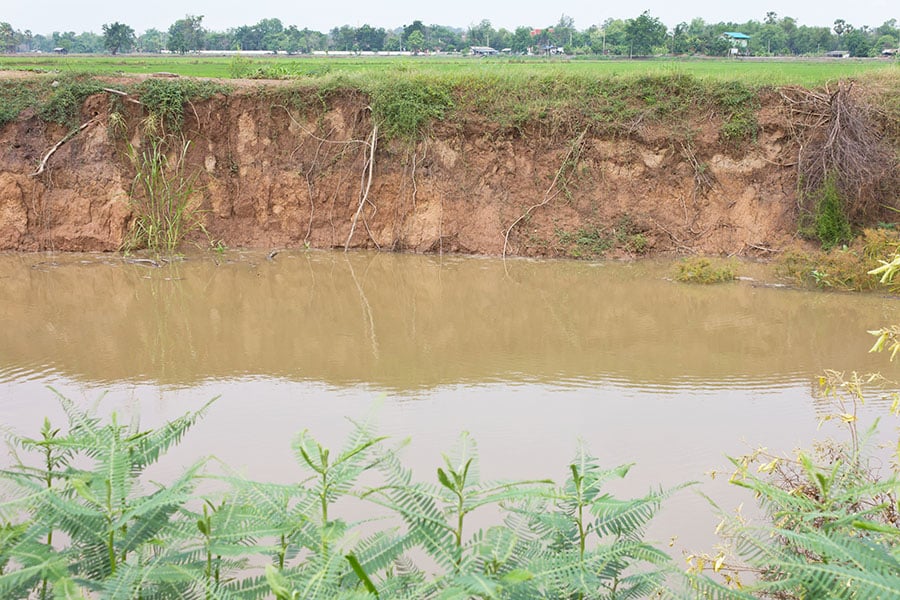If you do not address pressing erosion compromise on steep slopes, the project can result in failure.
Slopes with steep grades and little natural vegetation and growth are vulnerable to erosion. The forces of gravity, wind, and water can quickly undermine the structural integrity of a hill.
Controlling erosion on those steep slopes isn’t just about protecting the landscape. It reduces your liability, protects the surrounding properties and infrastructure from excess runoff, and prevents the loss of life and property.
The failure of a steep slope can ruin your company’s reputation and cost you and your firm millions.
The stakes are high.
Below are some common erosion control considerations and methods for steep slopes and those with limited natural vegetation.
What do I need to consider when choosing a steep slope erosion control measure?
As someone who works on complex commercial projects, you understand that every slope is different.
Factors like expected rainfall, elevation, typical wind speeds, surrounding infrastructure, and vegetation viability all impact slope integrity.
Steep slopes with limited vegetation usually require input from landscape architects, project managers, and many specialists.
Below are some considerations you already make when judging a steep slope situation. However, we challenge you to tackle them again in light of the slope stabilization method you choose.
Erosion Conditions
Assessing the extent of the erosion problem must be your first step before choosing a solution. Conduct a thorough analysis of how heavy rain impacts the area, wind and water conditions, and runoff potential.
The following all contribute to a less sturdy slope:
- Limited ground cover and stable vegetation
- Severe weather conditions, including tornados and hurricanes
- Steep slopes, especially those with a grade above 50%
Regulations and Policies
You must adhere to regulations and policies from organizations like the U.S. Department of Agriculture to the local government at the project site.
Be sure to familiarize yourself with the permitting process so that your project meets all local and federal requirements.
Risk and Liability
While this should not be the first consideration, determining the amount of risk and liability is one of the most important steps.
Based on the environmental conditions and slope composition, how likely is a failure of the slope?
Conduct a thorough analysis of the likelihood that the slope would fail and how it would affect the surrounding infrastructure and property.
Timeline and Budget
The erosion potential and risk and liability should drive your project’s timeline and budget. The more extensive the erosion issues and the more infrastructure those issues could affect, the higher the urgency.
Common ways to prevent soil erosion on a slope
Every slope stabilization and erosion control project has its own unique set of circumstances and conditions.
Consulting engineers and experts, especially with slope stabilization methods you’re unfamiliar with, ensure you construct a cost-effective and reliable structure.
There are a variety of potential solutions available for steep slope stabilization. Below are several commonly-used methods and resources to reduce soil and other forms of erosion.
Vegetation
The simplest and most natural solution to slope erosion control is natural vegetation. The root systems of grass, bushes, and trees all hold the soil in place, helping to stop erosion.
Vegetation is a more natural and long-term solution. For steep slopes, this means you may need a short-term, manufactured solution while the organic matter matures.
Terraces
A common way to stabalize a slope is by building terraces.
A properly-designed terrace stabilizes the slope by reducing both the speed and volume of soil and water runoff. Terraces also direct water so that it doesn’t flow into vulnerable areas at the bottom of the slope.
Depending on the budget, slope size and grade, and existing vegetation, you can use concrete blocks or wood to develop a terrace for your project.
Erosion Control Blankets
Erosion control blankets are a common method for steep slopes that you can use by itself or in concert with other options. They work especially well with natural vegetation and terraces.
Geocell
One of the most versatile and cost-effective erosion control and slope stabilization methods is geocell.
By staking the panels the entire length of the slope, you can prevent harsh wind and rain from compromising the slope integrity.
We recommend using soil from the slope as infill material for each cell, allowing for natural vegetation with a permeable honeycomb structure.
High-density polyethylene (HDPE) geocell grids are effective when traditional slope stabilization methods aren’t and can even work in concert with other methods.
Stone Facing
Riprap, concrete, and other aggregates are all different variations of stone-facing– a popular method for slope protection along shorelines. A mesh wire system contains stones, helping to secure a vulnerable slope.
Retaining Walls
Retaining walls are one of the most popular slope stabilization solutions across a variety of industries. This is due to both their functionality and their aesthetic appeal.
You can take advantage of different types of walls that support the slope depending on its grade and the expected wind and rainfall. These include vegetative retaining walls and gravity retaining walls.
Geocells for steep slope soil erosion control
The engineers at BaseCore understand the complexity of stabilizing steep, barren slopes. We also understand how high the stakes are and that you need a reliable slope stabilization method with accurate product specs and testing to prove it.
You don’t need to jeopardize your career and the loss of life and property due to a system failure of a steep slope.
Our team has implemented geocell panels on slope stabilization projects across the world. We can help you identify the best solution for your steep slope project with a project evaluation and answer any questions you have.
Give our our BaseCore engineers a call at 888-511-1553 and we’ll be glad to serve you as geocell experts.
